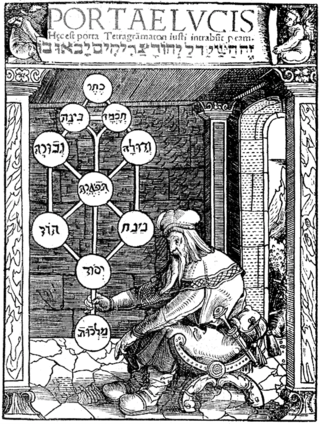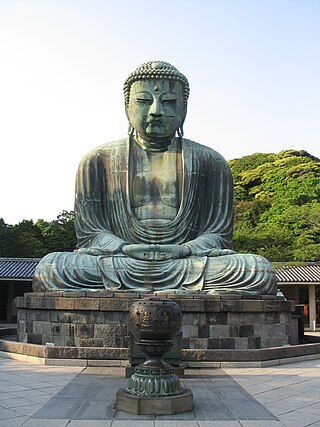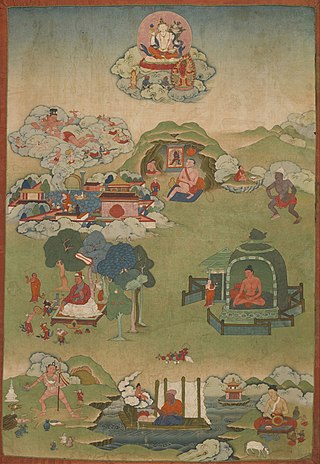
Archeosofica is a school of esoteric Christianity founded by Tommaso Palamidessi in 1968 in Rome. It offers a program of research on Archeosophy. [1]
Contents
The school is free and supplies booklets and other texts.[ citation needed ]

Archeosofica is a school of esoteric Christianity founded by Tommaso Palamidessi in 1968 in Rome. It offers a program of research on Archeosophy. [1]
The school is free and supplies booklets and other texts.[ citation needed ]
Archeosofica proposes a form of "ascesis" or asceticism: [2] [3]
Subjects of Archeosophy are explained in a series of booklets. There are about 50 Booklets on various subjects such as esoteric Christianity, reincarnation, out of body experiences, meditation, clairvoyance, esotericism, alchemy, religious symbolism, mysticism, and so on. [4] [ non-primary source needed ]

Chakras are various focal points used in a variety of ancient meditation practices, collectively denominated as Tantra, part of the inner traditions of Hinduism and Buddhism.
The meaning of spirituality has developed and expanded over time, and various meanings can be found alongside each other. Traditionally, spirituality referred to a religious process of re-formation which "aims to recover the original shape of man", oriented at "the image of God" as exemplified by the founders and sacred texts of the religions of the world. The term was used within early Christianity to refer to a life oriented toward the Holy Spirit and broadened during the Late Middle Ages to include mental aspects of life.

Tantra is an esoteric yogic tradition that developed on the Indian subcontinent from the middle of the 1st millennium CE onwards in both Hinduism and Buddhism.

Vajrayāna, also known as Mantrayāna, Mantranāya, Guhyamantrayāna, Tantrayāna, Tantric Buddhism, and Esoteric Buddhism, is a Buddhist tradition of tantric practice that developed in Medieval India and spread to Tibet, Nepal, other Himalayan states, East Asia, parts of Southeast Asia and Mongolia.

Asceticism is a lifestyle characterized by abstinence from worldly pleasures, often for the purpose of pursuing spiritual goals. Ascetics may withdraw from the world for their practices or continue to be part of their society, but typically adopt a frugal lifestyle, characterised by the renunciation of material possessions and physical pleasures, and also spend time fasting while concentrating on the practice of religion or reflection upon spiritual matters, which is thought by the practitioner to allow their core of consciousness to expand and connect with the infinite universal consciousness. Some individuals have also attempted an ascetic lifestyle to free themselves from addictions to things such as alcohol, tobacco, drugs, entertainment, sex, food, etc.

Kundalini yoga derives from kundalini, defined in tantra as energy that lies within the body, frequently at the navel or the base of the spine. In normative tantric systems, kundalini is considered to be dormant until it is activated and channeled upward through the central channel in a process of spiritual perfection. Other schools, such as Kashmir Shaivism, teach that there are multiple kundalini energies in different parts of the body which are active and do not require awakening. Kundalini is believed by adherents to be power associated with the divine feminine, Shakti. Kundalini yoga as a school of yoga is influenced by Shaktism and Tantra schools of Hinduism. It derives its name through a focus on awakening kundalini energy through regular practice of mantra, tantra, yantra, yoga, laya, haṭha, meditation, or even spontaneously (sahaja).

Western esotericism, also known as esotericism, esoterism, and sometimes the Western mystery tradition, is a term scholars use to classify a wide range of loosely related ideas and movements that developed within Western society. These ideas and currents are united since they are largely distinct both from orthodox Judeo-Christian religion and Age of Enlightenment rationalism. It has influenced various forms of Western philosophy, mysticism, religion, pseudoscience, art, literature, and music.
Yamabushi are Japanese mountain ascetic hermits. They are generally part of the syncretic shugendō religion, which includes Tantric Buddhist, Shinto, and Japanese Taoist elements.

Tapas is a variety of austere spiritual meditation practices in Indian religions. In Jainism, it means asceticism ; in Buddhism, it denotes spiritual practices including meditation and self-discipline; and in the different traditions within Hinduism it means a spectrum of practices ranging from asceticism, 'inner cleansing' to self-discipline by meditation practices. The Tapas practice often involves solitude and is a part of monastic practices that are believed to be a means to moksha.

Natha, also called Nath, are a Shaiva sub-tradition within Hinduism in India and Nepal. A medieval movement, it combined ideas from Buddhism, Shaivism and Yoga traditions of the Indian subcontinent. The Naths have been a confederation of devotees who consider Shiva as their first lord or guru, with varying lists of additional gurus. Of these, the 9th or 10th century Matsyendranatha and the ideas and organization mainly developed by Gorakhnath are particularly important. Gorakhnath is considered the originator of the Nath Panth.

Esoteric Christianity is a mystical approach to Christianity which features "secret traditions" that require an initiation to learn or understand. The term esoteric was coined in the 17th century and derives from the Greek ἐσωτερικός.
A spiritual practice or spiritual discipline is the regular or full-time performance of actions and activities undertaken for the purpose of inducing spiritual experiences and cultivating spiritual development. A common metaphor used in the spiritual traditions of the world's great religions is that of walking a path. Therefore, a spiritual practice moves a person along a path towards a goal. The goal is variously referred to as salvation, liberation or union. A person who walks such a path is sometimes referred to as a wayfarer or a pilgrim.

Buddhism, also known as Buddha Dharma and Dharmavinaya, is an Indian religion and philosophical tradition based on teachings attributed to the Buddha, a wandering teacher who lived in the 6th or 5th century BCE. It is the world's fourth-largest religion, with over 520 million followers, known as Buddhists, who comprise seven percent of the global population. Buddhism originated in the eastern Gangetic plain as a śramaṇa–movement in the 5th century BCE, and gradually spread throughout much of Asia. It has subsequently played a major role in Asian culture and spirituality, eventually spreading to the West beginning in the 20th century.

Tibetan tantric practice, also known as "the practice of secret mantra", and "tantric techniques", refers to the main tantric practices in Tibetan Buddhism. The great Rime scholar Jamgön Kongtrül refers to this as "the Process of Meditation in the Indestructible Way of Secret Mantra" and also as "the way of mantra", "way of method" and "the secret way" in his Treasury of Knowledge. These Vajrayāna Buddhist practices are mainly drawn from the Buddhist tantras and are generally not found in "common" Mahayana. These practices are seen by Tibetan Buddhists as the fastest and most powerful path to Buddhahood.

Tommaso Palamidessi was an Italian esotericist. Drawn to astrology, parapsychology, and yoga-tantric doctrines, he was active in the field of the occult and developed a form of Esoteric Christianity that he called Archeosophy. In 1968 he founded the Archeosophical Society in Rome, which is still active and has several thousand members in Italy and the rest of Europe.
In Christian theology, cardiognosis is a special charism that God confers on some saints. In Christian asceticism, the term Cardiognosis also indicates the ascetical methods and meditation techniques which have the purpose of reaching an inner state of mystical experience and, eventually, the charisma of Cardiognosis.

Disciplina arcani was a custom that prevailed in the 4th and 5th centuries of Christianity, whereby knowledge of certain doctrines and rites of the Christian religion was kept from non-Christians and even from those who were undergoing instruction in the faith so that they may progressively learn the teachings of the faith and not fall to heresy due to simplistic misunderstandings.
The Guardian of the Threshold is a menacing figure that is described by a number of esoteric teachers. The term "Guardian of the Threshold", often called "Dweller on the Threshold", indicates a spectral image which is supposed to manifest itself as soon as "the student of the spirit ascends upon the path into the higher worlds of knowledge". The Guardian of the Threshold is also the title of the third play written by Rudolf Steiner in 1912.
Body of resurrection is a typical term of Esoteric Christianity, used to indicate a spiritual body associated with a special enlightenment or experience. Many western and Eastern traditions share a common doctrine on a spiritual and immortal body which represent the ultimate goal of many ascetical works.